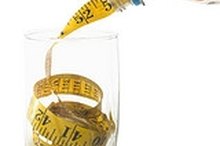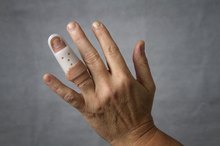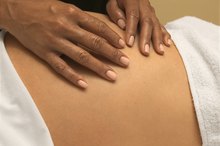The Benefits of Magnetic Rings
The use of magnets for various health conditions dates back many centuries; Greek physicians were practicing magnet therapy by the third century A.D. Proponents of wearing a magnetic ring may have health benefits, including increasing circulation, alleviating pain and aiding injury recovery. More studies are necessary to determine the therapeutic effects of magnetic rings. Stephen Barrett, M.D., says that there is no scientific evidence to conclude that small, static magnets can relieve pain or influence the course of any disease.
Increase Circulation
Magnetic rings may have therapeutic benefits for conditions related to poor circulation to the extremities, including cold or numb hands and feet. The Center for Complementary and Alternative Medicine reports that scientific researchers and magnet manufacturers propose that magnets can increase the flow of blood to tissues and can increase the temperature of the treated area. This theory has not been conclusively proved. Consult your health care provider if you experience numbness in your extremities and do not stop any conventional treatment you are receiving in favor of magnets.
- Magnetic rings may have therapeutic benefits for conditions related to poor circulation to the extremities, including cold or numb hands and feet.
- Consult your health care provider if you experience numbness in your extremities and do not stop any conventional treatment you are receiving in favor of magnets.
Pain Relief
Health Effect of Magnets
Learn More
Magnetic rings are propose as an alternative medicine method of addressing finger and wrist pain such as discomfort caused by arthritis or carpal tunnel syndrome. According to theory, therapeutic magnets may change how nerve cells function and may block pain signals to your brain. This theory is not supported by medical literature; the Center for Complementary and Alternative Medicine reports that there is no convincing evidence that magnets can relieve pain of any type.
Injury Recovery
Wearing a magnetic ring may assist the healing of injuries to your hands or feet, supporters say. Therapeutic magnet manufacturers claim that magnets promote healing by stimulating circulation and bringing oxygen and nutrients to damaged tissues. The Center for Complementary and Alternative Medicine is sponsoring research on the effects of magnets on networks of blood vessels involved in healing. A preliminary study conducted by the National Institutes of Health suggests that magnets do not affect blood flow in healthy people.
- Wearing a magnetic ring may assist the healing of injuries to your hands or feet, supporters say.
- A preliminary study conducted by the National Institutes of Health suggests that magnets do not affect blood flow in healthy people.
Related Articles
References
- Quack Watch: Magnet Therapy--A Skeptical View
- Center for Complementary and Alternative Medicine: Magnets for Pain
- Bausell RB. Snake Oil Science: The Truth about Complementary and Alternative Medicine. New York, NY: Oxford University Press; 2007.
- Weiner RS. Pain Management: A Practical Guide for Clinicians, Sixth Edition. CRS Press: Boca Raton, FL; 2002.
- Arndt M. Bloomberg News. Florsheim Shoes' Magnetic Appeal. July 3, 2000.
- Justia Patents. Dynamic magnetic device and method, and components thereof. Feb 13, 2002.
- Yuksel C, Ankarali S, Yuksel NA. The use of neodymium magnets in healthcare and their effects on health. North Clin Istanb. 2018;5(3):268-273. doi:10.14744/nci.2017.00483
- Winemiller MH, Billow RG, Laskowski ER, Harmsen WS. Effect of magnetic vs sham-magnetic insoles on nonspecific foot pain in the workplace: a randomized, double-blind, placebo-controlled trial. Mayo Clin Proc. 2005;80(9):1138-45. doi:10.4065/80.9.1138
- Jonas WB. Reframing placebo in research and practice. Philos Trans R Soc Lond, B, Biol Sci. 2011;366(1572):1896-904. doi:10.1098/rstb.2010.0405
- Weintraub MI, Wolfe GI, Barohn RA, et al. Static magnetic field therapy for symptomatic diabetic neuropathy: A randomized, double-blind, placebo-controlled trial. Arch Phys Med Rehabil. 2003;84(5):736-46. doi:10.1016/s0003-9993(03)00106-0
- Federal Trade Commission. Federal Trade Commission Decisions Complaint in the Matter of Magnetic Therapeutic Technologies, Inc., et al. 1999.
- Winemiller MH, Billow RG, Laskowski ER, Harmsen WS. Effect of magnetic vs sham-magnetic insoles on plantar heel pain: a randomized controlled trial. JAMA. 2003;290(11):1474-8. doi:10.1001/jama.290.11.1474
- Riskowski J, Dufour AB, Hannan MT. Arthritis, foot pain and shoe wear: current musculoskeletal research on feet. Curr Opin Rheumatol. 2011;23(2):148-55. doi:10.1097/BOR.0b013e3283422cf5
- Basford JR. A historical perspective of the popular use of electric and magnetic therapy. Arch Phys Med Rehabil. 2001;82:1261-9.
- National Center for Complementary and Integrative Health. Magnets. Updated February 2013.
Writer Bio
Jason Marcus began writing alternative medicine and winter sports articles for LIVESTRONG.COM in 2010. He practices holistic healing as a nationally certified massage therapist. He studied at the Cayce/Reilly School of Massotherapy. Marcus holds a Bachelor of Science in biology and he completed the pre-medicine program and received summa cum laude graduate honors from James Madison University.









